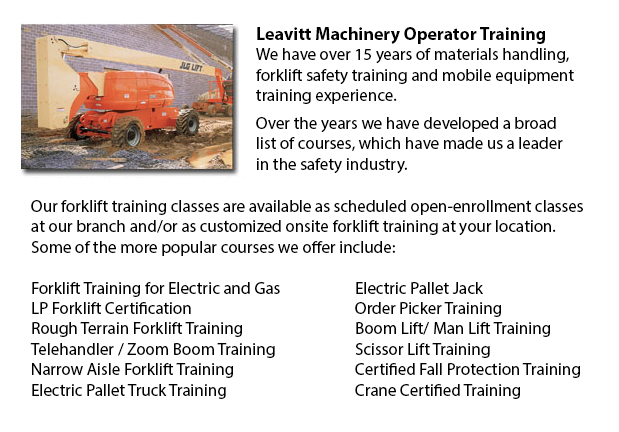
Aerial Boom Lift Training Kelowna - Aerial Boom Lift Training is required for any person who operates, supervises or works near boom lifts. This particular kind of aerial lift or aerial work platform is used for lifting individuals, tools and materials in projects requiring a long reach. They are generally utilized to access utility lines and other above ground job-sites. There are different types of aerial booms lifts, like articulating boom lifts, extension boom lifts and cherry pickers. There are two kinds of boom lift: "telescopic" and "knuckle".
Boom lift training is important and usually involves the essential operations, equipment and safety concerns. Workers are required while working with mobile machinery to know the safe work practices, rules and dangers. Training program materials provide an introduction to the terminology, uses, concepts and skills required for workers to obtain competence in operating boom lifts. The material is aimed at workers, machine operators and safety professionals.
This training is adaptive, cost-effective and educational for your business. An effective and safe workplace could help a business attain overall high levels of production. Fewer workplace accidents occur in workplaces with strict safety rules. All equipment operators should be trained and evaluated. They require knowledge of present safety measures. They should comprehend and adhere to guidelines set forth by the local governing authorities and their employer.
Employers must ensure that their employees who operate aerial boom lifts get right training in their safe use. Operator certification is required on each different kind of aerial equipment utilized in the workplace. Certifications are offered for aerial work platforms, articulating booms, scissor lifts, industrial forklift trucks, and so on. Employees who are fully trained work more effectively and efficiently compared to untrained workers, who need more supervision. Correct instruction and training saves resources in the long run.
Training is the best prevention for the main causes of workplace fatalities: electrocutions, falls and collapses or tip overs. Aside from training, the best way to avoid workplace accidents is to maintain and operate aerial work platforms according to the instructions of the manufacturer. Allow for the total weight of the materials, worker and tools when following load restrictions. Never override mechanical, electrical or hydraulic safety devices. Workers must be securely held in the basket using a body harness or restraining belt with a lanyard attached. Do not move lift equipment whilst workers are on the elevated platform. Workers should be careful not to position themselves between the beams or joists and basket rails in order to avoid being crushed. Energized overhead power lines must be at least 10 feet away from the lift equipment. It is suggested that workers always assume wires and power lines might be energized, even if they appear to be insulated or are down. If working on an incline, set brakes and make use of wheel chocks.
-
Counterbalance Forklift License Kelowna
Counterbalance Forklift License Kelowna - Forklifts, when operated by completely trained workers, are a major advantage to companies. We offer a thorough training program consisting of all parts of operating a powered lift device. Counterbalance fork... More -
Forklift Certification Schools Kelowna
Forklift Certification Schools Kelowna - Within North America, forklift certification is mandatory, making forklift training programs important for both the company and their employees working as forklift operators. Forklift training focuses on healt... More -
Manlift Operator Certification Kelowna
Manlift Operator Certification Kelowna - We provide a scissor platform and aerial lift training and certification to empower the trainee with the general understanding and knowledge of the safe and efficient utilization of "Power Operated Mobile Work... More -
Crane Training Schools Kelowna
Crane Training Schools Kelowna - We have designed several programs for Mobile Crane Operation at our Crane Training Schools. These programs are recommended for the experienced operator who requires re-certification or certification, and for inexperie... More -
Heavy Equipment Operator Classes Kelowna
Heavy Equipment Operator Classes Kelowna - A heavy equipment operator is a person who has received the proper training to operate a particular type or piece of machine. There are a lot of ways for the operator to undergo training and certification in... More -
Telehandler, Rotational Telehandler, Zoom Boom Training in Kelowna
Telehandlers or also known as Telescopic handlers are really popular piece of heavy construction equipment normally utilized in agriculture and construction trades. These equipments have extreme reaching capability and could get to places where a tra... More -
Zoom Boom Training Kelowna
Zoom Boom Training Kelowna - Zoom Boom Training is intended to train operators on variable reach forklifts. The goals of the training are to impart an understanding of the physics of the equipment, and to outline the operator's tasks. This course fol... More -
Boom Lift Safety Training Kelowna
Boom Lift Safey Training Kelowna - Boom lifts fall under the type of elevated work platform or aerial lifting device. Most normally utilized in construction, industry, and warehousing; the boom lift is so versatile that it can be utilized in almost w... More

Forklift Training Kelowna
TOLL FREE: 1-888-254-6157
Kelowna, British Columbia
forklifttraininginkelowna.com
Email Us
About Us


